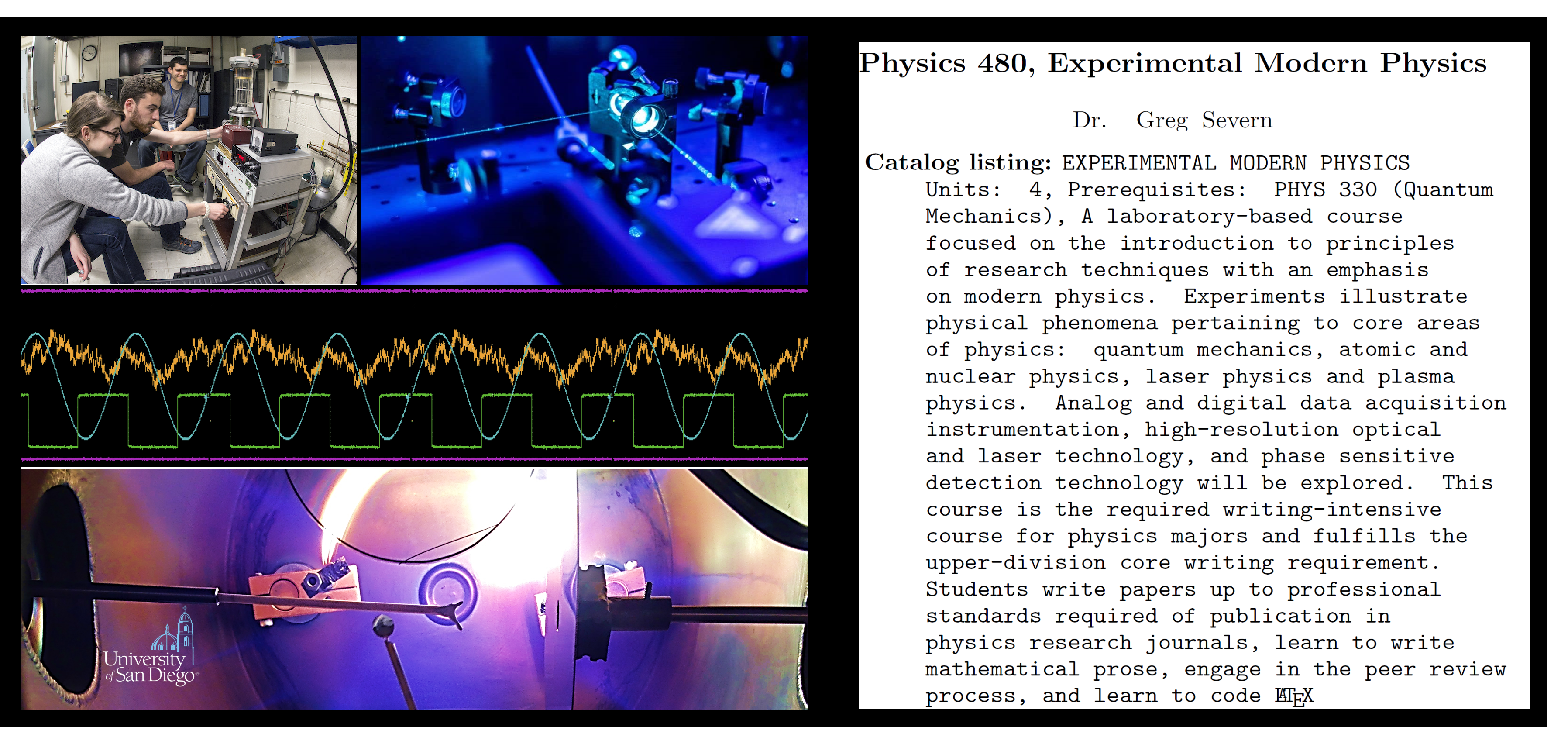
"The life of a great scientist in his laboratory is not, as many may think, a peaceful idyll. More often, it is a bitter battle with things, with one's surroundings, and above all with oneself. A great discovery does not leap completely achieved from the brain of the scientist, as Minerva sprang, all panoplied, from the head of Jupiter; it is the fruit of accumulated preliminary work." -- Marie Curie, p.69, from "Pierre Curie", Dover Publication, 1963
"Experimental physicists confront nature through instruments, their daily work largely determined by the character of the apparatus." -- Peter Galison, p. 315, from "image & logic, a material culture of microphysics", Chicago U.P., 1997
Physics 480 Laboratory
Experimental Modern Physics (EMP)
Physics 480 Fall 2024
Primary Text: Experiments in Modern Physics, 2nd Ed., A.C. Melissinos and J. Napolitano,
Academic Press, 2003.
Dr. Greg Severn
severn@sandiego.edu, X6845, ST282
[Office Hours] M 1:30-3:00 ish (I will be getting off a zoom at 1:30, praying for patience for all parties; T 2:00-3:30; Th 1:30-3:30
but in any case, let's figure out an appointment! Shoot me an email (in the usual way, please include PHYS480 in the subject line:), or use Canvas
Course Description
PHYS 480 Experimental Modern Physics
Units: 4, Prerequisites: PHYS 330 (Quantum
Mechanics), A laboratory-based course
focused on the introduction to principles
of research techniques with an emphasis
on modern physics. Experiments illustrate
physical phenomena pertaining to core areas
of physics: quantum mechanics, atomic and
nuclear physics, laser physics and plasma
physics. Analog and digital data acquisition
instrumentation, high-resolution optical
and laser technology, and phase sensitive
detection technology will be explored. This
course is the required writing-intensive
course for physics majors and fulfills the
upper-division core writing requirement.
Students write papers up to professional
standards required of publication in
physics research journals, learn to write
mathematical prose, engage in the peer review
process, and learn to code in $\begin{equation}\LaTeX \end{equation}$.
Guide to Course Policies, description of experiments, LaTeX stuff, and all that...
Note: Subject to change Calendar for Fall 24--note due dates for submissions!

Information for PHYS 480W authors

Journal Submissions (manuscripts and reviews) happen on BB ....
Each student is required, to begin with, to submit a complete manuscript. Is the student ready to begin writing? Here is a flow chart for writing just the introduction. The point of reducing one's approach to a kind of algorithm is to see it more objectively, and to improve upon one's method. Bear in mind that this is just for the introduction, and maybe this won't happen to you.
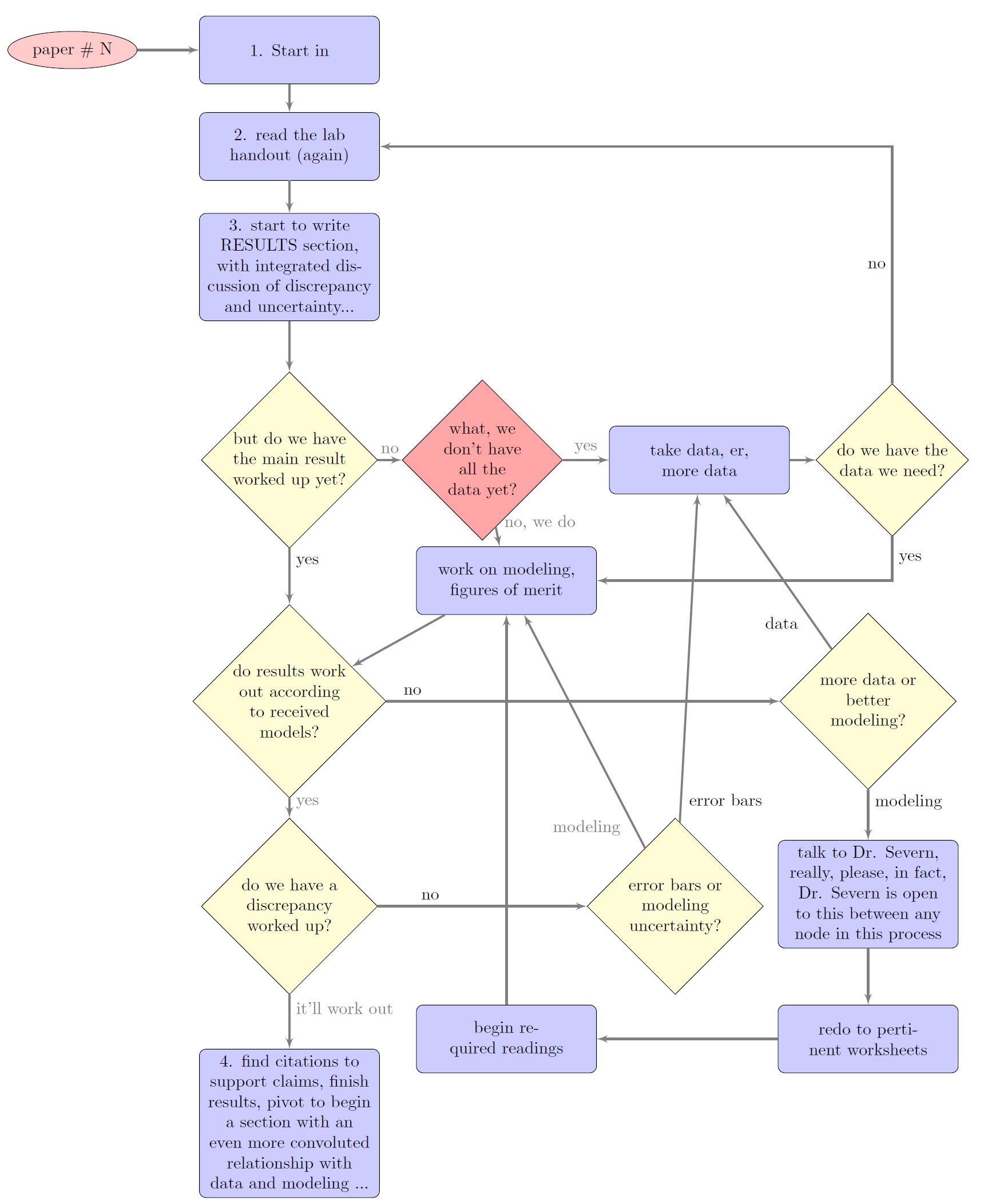
Immediately afterward, one submits a peer review, and later (once the reviews are in) a revised final
manuscript along with a cover letter, or 'rebuttal letter'. Here's a flow chart of the overall process.
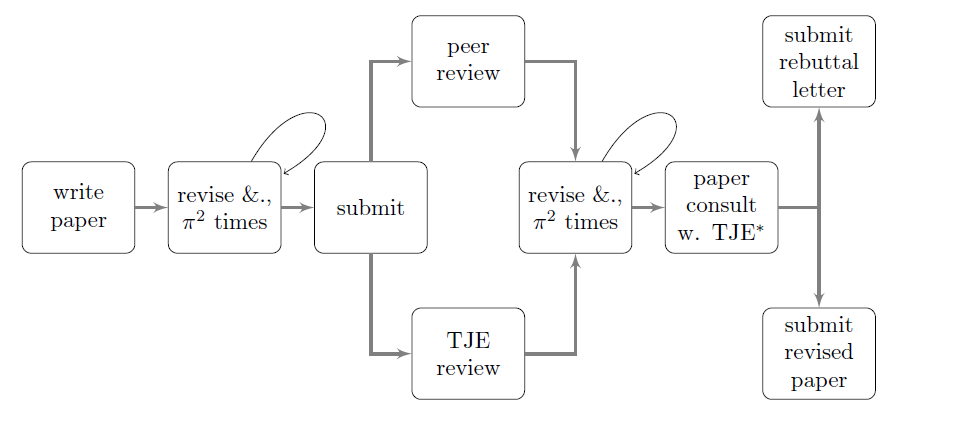
The asterisk means that the consult is scheduled at the initiative of the author. The TJE is often distracted with other reviews beside yours. This is wonderful and sad all at the same time, not to mention frustrating. So, send an email, and read the parable of the unjust journal editor, found in the Gospel of Luke 18:1-8, (SRV$^**$, oops, sorry, $\LaTeX\$error;$&*#$\clubsuit$... (SRV$^{**}$:).
If first submission of the manuscript is not deemed complete, then the instructor puts his or her other hat on, that of the 'Tyrant Journal Editor', and according to the whims of the Tyrant Journal Editor, the manuscript will or will not go out for reviews. This is devoutly to be avoided. Journal Editors speak dictatorially, imperiously, and always finally. As they have always
been a kind of tyrant, the instructor of the course will not break the mold. So, it is in
your interest to PLAY BY THE ROOLS. (Tyrants have traditionally had
trouble spelling).
A NEW ROOL:
Each final submission is to be accompanied by
a cover letter stating your name as the author of the work, and listing the colleagues
in your research group (with whom you had significant discussions about
the execution of the experiment). The most important part of the cover letter
is this: a point-by-point response to each referee.
A 'point-by-point response' to each reviewer will be almost impossible, however, without being very tedious. A suggestion: itemize what you think were
significant ones. Don't include every little 'copy edit', but, as you are revising your texts this weekend,
keep track of the significant changes and itemize them in a simple list. These items can be a simple and broad as, `reviewers
asked for more background in the introduction: I added an indication of the connection between optical pumping and the LASER....', or, 'all the sentence pathologies noted by the reviewers were considers and the each of those sentences
were reworked'. Note that such a cover letter indicates that you have considered how to make changes in your manuscript, and serves as a guide to the reader to those changes that you did in fact make. This
is hugely important!
There is a letter environment in LATEX:
\documentclass{letter}
\begin{document}
... letters ...
\end{document}
Each letter is a letter environment, whose argument is the name and address of the recipient. For example, you might have
\begin{letter}{Mr. J. Coffee \\ Dept. of Physics
\\ University of San Diego}
\opening{Dear Tyrant Journal Editor,}...
\end{letter}
Give it a try!

But why (oh why) do we still need a lab notebook, a nice one, if we never turn it in for a score?
The tutorial nature of the course, I mean, why do this course tutorialy? Note: beginning Sp24, these will be folded into class times (somehow! work in progress....)

Tutorial teaching in PHYS 480W generally involves very small groups meeting with the tutor (generally the instructor of record) once or twice a week. A list of questions
is prepared to which the students respond with written out solutions, delivered discursively as well as algebraically, often festooned with cartoon figures as aids for ones understanding of
the solution to the prompt. At the tutorial session, the tutor and student(s) discuss the work with a view toward mutual critical evaluation and deep down understanding. Questions and comments fly. The student
is expected to piece things together for him or herself, to become critical of written materials (everything from research papers to lab manuals) so that at length the student improves
at producing them. Besides being terrifying, it's kinda fun. And a lot of work.
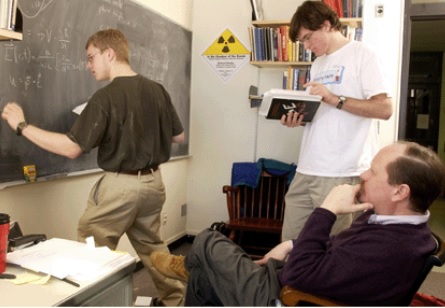
(PW) Plasma Physics & Plasma waves Readings
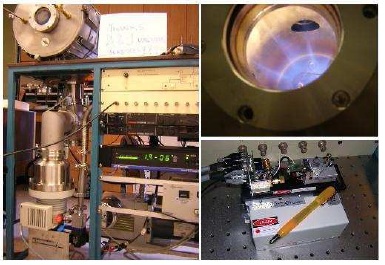
- lab handout for the Plasma Waves (PW). Note: I am trying to remember to include a lightly annotated copy of a section in Horrowitz & Hill, The art of electronics, awesome resource about electronics in service of experimental physics, a section about lock-in-amplifiers....
- Ok, here is a copy of a section in Horrowitz & Hill, The art of electronics, awesome resource about electronics in service of experimental physics, a section about lock-in-amplifiers....
- Merlino's paper on Langmuir probes
- How to derive the dispersion relation for sound (acoustic) waves
- Notes on ion acoustic waves
- Worksheet on ion acoustic waves (w. feedback)
- Langmuir probe signals, absorption spectroscopy signals, and distribution functions (w. feedback)
- A note on the plasma sheath and the Bohm Criterion
- A 2-pager on cool things to note about lightning
- da Silva C L, Sonnenfeld R G, Edens H E, Krehbiel P R,
Quick M G and Koshak W J 2019 The plasma nature of
lightning channels and the resulting nonlinear resistance J.
Geophys. Res.: Atmos. 124 9442íV63
(LS) Laser Spectroscopy & Saturation Absorption Spectroscopy Readings
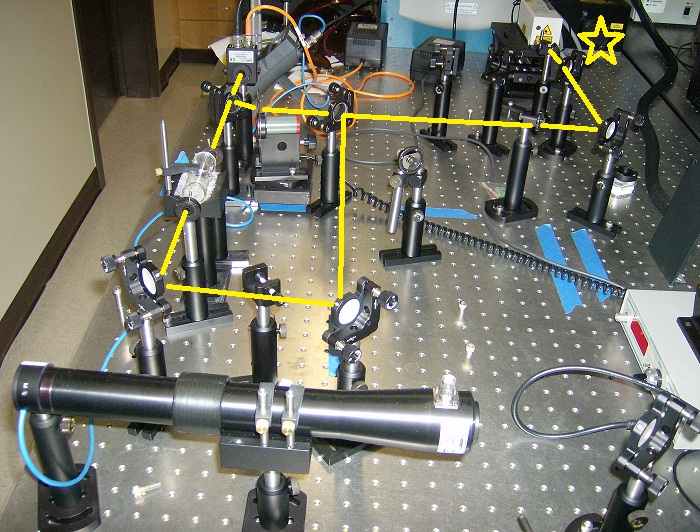
- Hyperfine structure of Rb I: laser spectroscopy experiments handout
- laser safety stuff; read this article, then we'll talk about the 20mW-ish NIR laser we're using for this experiment....*NO BODY GETS TO MESS WITH THE LASER Without TAKING AND PASSING THE LASER SAFETY QUIZ*
- Chapter 6 in the text, especially sections 6.3 and 6.6.
- G. N. Rao, M. N. Reddy, and E. Hecht, 'Atomic hyperfine structure studies using temperature/current tuning
of diode lasers: An undergraduate experiment', Am. J. Phys., 66 (8), 702-712 (1998).
- Daryl W. Preston, 'Doppler-free saturated absorption: Laser spectroscopy', Am. J. Phys., 64 (11), 1432-1436 (1996).
- K. Razdan and D. A. Van Baak, 'Demonstrating optical saturation and velocity selection in rubidium
vapor', Am. J. Phys., 67 (9), 832ff (1999).
- Nobel prize for physics, 1981; see especially Schawlow's lecture
- PHYS 272 level notes on Blackbody radiation incl. Einstein's `discovery' of stimulated emission of radiation (A & B coefficients, the 1917 paper)
- A brief note on Fabry-Perot etalons
- An even briefer note on on the brief Fabry-Perot etalon note (one page)
- A worksheet for etalons as `optical resonators'
- `Deliberate Practice' reference referred to in etalon worksheet:)(I like this stuff toooooo)
- The brochure for our confocal etalon; note, our FSR is C/4L.
- A brief note on lock-in amplifiers and phase-sensitive detection
(OP) optical pumping readings

- optical pumping in Rb lab handout
- a pdf of the Optical Pumping Manual is on the Blackboard course site
- Optical Pumping lab manual; copy in SCST 292
- Ch.6 in the text, ``High Resolution Spectroscopy", esp. section 6.6.2
- Optical Pumping `Conceptual Introduction'
- Nobel Prize presentation address for the optical pumping award.
- David J. Griffiths, Hyperfine splitting in the ground state of hydrogen, Am. J. Phys. 50 (8), 698-703 (1982). Note that you will be
expected to learn to do primary literature searches using the library's resources. Moreover, you will be expected to read, study, calculate, conceptualize, and
work out misconceptions with the aid of these resources along with the ones listed above. Stay tuned to suggested references as they come up
in tutorial meetings, lab sessions, and in lecture.
(PNMR) pulsed nmr readings
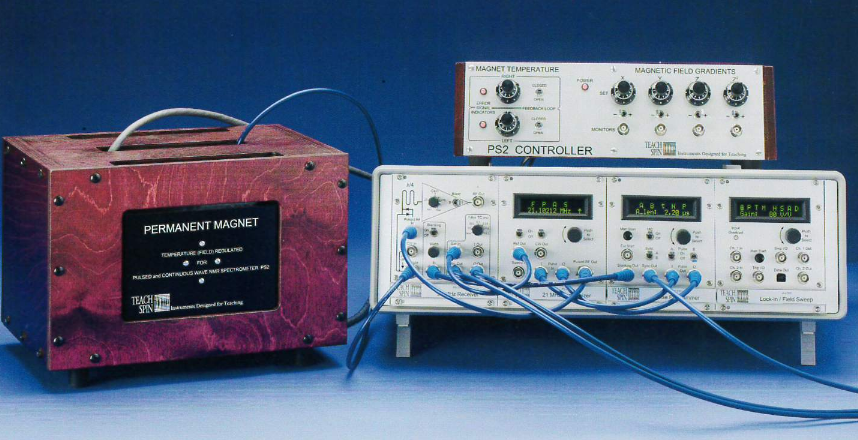
- pulsed nuclear magnetic resonance lab handout-NOTE-deliverables edited for remote labs
- a pdf of the Pulsed NMRManual is on the Blackboard course site
- Ch.7 in the text, ``Nuclear Magnetic Resonance", esp. section 7.1-7.4
- Conceptual tour of the original TeachSpin PNMR apparatus
- Conceptual tour of the TeachSpin PS-2 PNMR apparatus
- TeachSpin documentation for pulsed pnmr apparatus.
- W. Kein, Nuclear magnetic resonance: Free-induction decay and spin echoes in a 0.05T magnetic field, Am. J. Phys. 58 (2), 143-147 (1990). Note that you will be
expected to learn to do primary literature searches using the library's resources. Further, you will be expected to read, study, calculate, conceptualize, and
work out misconceptions with the aid of these resources along with the ones listed above. Stay tuned to suggested references as they come up
in tutorial meetings, lab sessions, and in lecture.
(RO) rabi oscillations readings
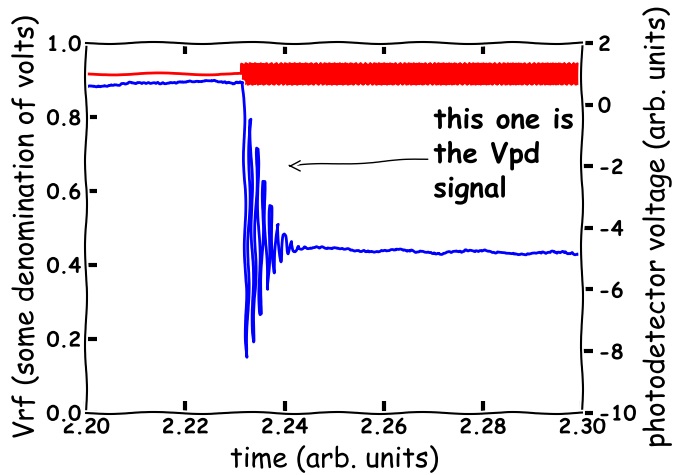
$L_{A}T_{E}X$ readings
Some of the class notes, worksheets, 'notes on...', etc...
These topics sort of span the space of necessary advanced NRQM (non-relativistic quantum mechanics) , plasma physics, and other stuff, including worksheets...the
more complete repository of worksheets will be on the BB course site.
- class organization, and goals, what you are in for this semester, first pass at Mermin's 3 rules, etc...
-
-
File translated from
TEX
by
TTH,
version 3.81.
YOU KNOW YOU CAN NEVER TRUST THESE DATES.....most recent fiddling, Jan. 6 2024, which is no proof that all errors are corrected, or dated properly...also...
$^{**}$ refers to SRV = Severn Revised Version












